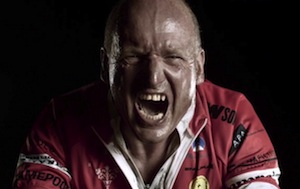As promised, following the interviews with Tom Scotto and Dr. Haley Perlus on the physical and metal aspects of pushing into the realm of discomfort, here are some of Tom’s and my favorite cues for hard to very hard efforts that include an element of suffering.
Cycling is a beautiful sport, one that can be experienced at all extremes. It can be a casual stroll along a family bike path, or a moderate aerobic effort over mildly rolling hills and meandering country roads, or it can be a challenging grind over 10-mile steep grades.
Bicycle racing is one of the toughest sports in the world, whether a grueling cross-country mountain bike race, a blistering criterium, a one-hour time trial, a short intense track sprint, or a 21-day stage race. These efforts demand that riders dig deep into their souls to find the will to push beyond pain and suffering.
You don’t have to be a racer to experience that kind of challenge. Many non-racers who prepare for, and put themselves through events such as century rides with 10,000 feet of climbing experience a similar kind of suffering.
Also, the physical and mental challenge one endures when riding a bike over a 10,000 foot mountain peak is a spiritual experience. This kind of “suffering” connects you to your soul.
Fitness is similar. For those seeking general health benefits and maintenance, the effort put out may be only moderately challenging, and the enthusiast may never get to the point of physical or mental suffering. For them, the “no pain, no gain” mantra is unnecessary. There is nothing wrong with this mindset and we should get to know our students and their goals well enough so that we know when pushing them too hard is truly unnecessary.
But for those who seek substantial changes in their bodies, such as weight loss, increased muscle mass, and especially improvements in performance, it demands efforts that take them to the edge and beyond. It requires a mental mind-set to do what others won’t do, to persist when others quit, and a commitment to coming back again and again until they can do it longer and better than before. And as Tom Scotto and Dr. Haley Perlus and I have discussed, it demands overcoming pain and suffering. Attaining fitness goals that others find impossible or overwhelming is also a spiritual experience, much like the experience of cycling outdoors.
As coaches of cycling classes, we have that unique opportunity to inspire our students to do what they never thought possible. We have to be cognizant that this kind of progress doesn’t come easily and that it doesn’t happen overnight. We must be patient as the instructor, and we have to guide our students to be patient in their quest. But little by little, we can teach them to overcome discomfort for longer and longer periods. In the process, their fitness and performance will skyrocket.
You must already have had the discussion with your riders about when it’s appropriate to hold back and when it’s OK to push beyond the edge. You must have already taught them to discern the difference between what Dr. Perlus calls “functional” and “non-functional” pain.
The following cues assume that you have already gone through this discussion with your students, and if we use the terms pain, hurt, or suffering, you understand that we are of course referring to “functional pain,” not pain that is injurious and dangerous.


Thank you for this post! It is so nice to hear how experts cue high intensity efforts! I feel as if I always repeat the same wording to coach and challenge the students. I used many of your cues after reading this and it was great! Thank you!